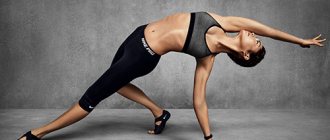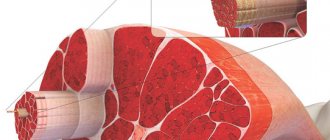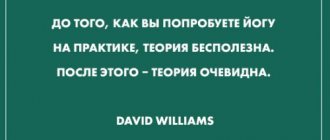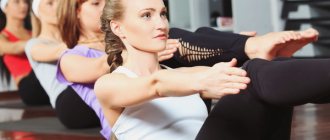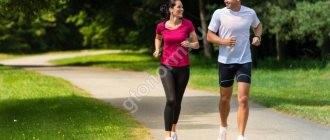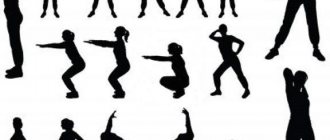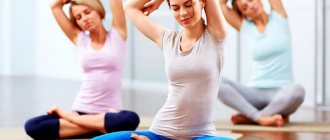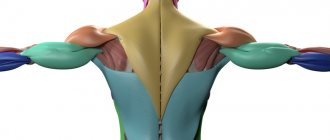Flexibility is a word that gets thrown around regularly in the health and fitness industry, but what does it really mean, why is it important and how can you develop it? In this article we will look at what exactly stretching exercises provide, what types there are and what are the benefits of them.
Factors that influence flexibility:
- Muscle elasticity: Damaged, weak, undeveloped muscles are less flexible. For people with weak muscles, stretching gives a particularly noticeable effect on flexibility.
- Elasticity of tendons.
- Weak ligaments: After an injury, ligaments can become weak, leading to excessive joint movement. Some people are born with weak ligaments that need to be trained. This is the benefit of stretching - the exercises are aimed specifically at training muscles.
- Ability of muscles to relax: Some muscles cannot relax completely due to increased tone.
- Temperature of the joint and associated tissues: Joints and muscles provide better flexibility at a body temperature that is 1-2 degrees higher than normal.
- Bone structures that restrict movement: Some people develop bone spurs known as spurs, which can restrict movement of the body and limbs.
- Ambient temperature: Warm air promotes flexibility.
- Time of day: In the morning, flexibility is reduced.
- Age: Flexibility tends to decrease with age.
- Gender: Women are on average more flexible than men.
Types of stretching
Before you start practicing stretching and choose the optimal training program, you need to understand the types and properties of stretching.
- Static stretching. This type of stretching is one of the most common among yoga and strength sports enthusiasts. The main task is to stretch the muscle fibers to the maximum and hold the pose for about 20 - 30 seconds. This type of stretching has the useful property of directing the entire main load to the muscles, tendons and joints, so a person should have a feeling of smooth stretching. Static stretching will be especially useful when practicing splits and other gymnastic stances. Important! To avoid harm from injury, pain should never be allowed.
- Passive stretching. According to the technique of execution, passive stretching is similar in properties to static stretching. However, this will require the presence of a trainer or partner who will gently physically influence the trainee’s body. For muscle stretching to be effective, the person performing the exercises must breathe deeply.
- Dynamic stretching. It is characterized by controlled movements of the limbs - both slow and fast. Dynamic stretching has the beneficial property of improving blood circulation in muscle fibers, thereby preparing the body for the upcoming load. And in combination with a warm-up, stretching can work out those areas of the body that will be subject to maximum tension.
- Ballistic stretch. In contrast to dynamic, it is characterized by uncontrolled body movements in space. This type of stretching is considered a rather dangerous training option and is used in the field of martial arts. At the initial stage of stretching practice, it is not recommended to use the ballistic stretching technique, so as not to cause harm to unprepared muscles and the body as a whole.
- Active stretching. During its execution, individual muscles of the body are stretched, which has the benefit of warming them up both before and after classes. The properties of this technique will be especially useful in reducing the load on the joints, increasing the range of mobility, and the elasticity of muscle fibers. For an active type of stretching, it is recommended to use a clothesline, a jump rope, an elastic bandage, a belt, or a regular belt: with their help, you can independently train the necessary areas of the body. The technique involves maintaining a certain position using muscle strength, without any additional help. The tension of one type of muscle during stretching helps to relax the antagonist muscles due to mutual balancing.
- Isometric stretching. It involves alternating relaxation with tension. The most common example is the splits: when a person takes the appropriate position and lowers himself slightly, until there is slight pain, and then tenses the leg muscles as if he wants to rise - and holds this position for about 20 seconds, after which he relaxes again and falls even lower.
- Proprioceptive neuromuscular stretching. To perform it, you need the help of a coach or partner. The idea is to contract the muscle as much as possible, after which it is statistically stretched. It is important to remember that the stretched muscle must be given a rest for 15 - 20 seconds before performing the next approach - this will allow it to relax a little and prevent harm from injury.
Rules for effective and safe stretching
Muscles must be warmed up
Therefore, the ideal time for stretching is after strength training, or better yet, cardio training. If you devote a separate session to stretching, doing a warm-up is a must. 10-15-minute cardio is suitable: running, burpees, steps from classical aerobics (important - with the active participation of the arms, you can take light dumbbells of 1-2 kg). Pulling unheated muscles is not only less effective, but also dangerous.
Stretching doesn't have to be long
An hour is the maximum. In 30-40 minutes you will ensure a full stretch of the whole body and will not overwork it. If you perform stretching solely for the purpose of relaxing “clogged” muscles and preventing their shortening, then generally 15-20 minutes after the main workout will be enough. But, of course, you won’t break your personal flexibility records.
Exercise regularly
The optimal option is 3-4 times a week, regardless of whether you stretch as a separate workout or as an addition to strength training and cardio. Don’t overdo it: you don’t need a full-fledged flexibility workout every day—the muscles should also have time to recover from thorough stretching, just like from strength training. Infrequent exercise, in turn, will not produce any effect.
Each time we stretch the whole body
From neck to ankle. Not focusing on one split or leaning towards your feet is important not only for the harmonious development of the body. The fact is that individual stretching exercises involve more muscles than we used to think. For example, for the same cross split, you need to pull not only the inner surfaces of the thighs, but also the lower back - without this you will not be able to do a full split.
Muscles should be relaxed
Tense muscles, in principle, do not stretch; the effect of such training is an illusion. Relaxation is ensured by two conditions.
First, moderate load. There is no need to stretch in the maximum position available to you: if you are in pain, the body reacts to it as to any stress - with mobilization, tension. Therefore, the sensations should be unpleasant, but quite tolerable. If you lose your breath and want to get out of the pose as quickly as possible because you don’t have the strength to endure it, moderate your ardor.
Secondly, you need enough time to relax. Therefore, we hold each pose for at least 30-45 seconds. 3-4 approaches for each muscle group are enough.
The benefits of stretching
To begin with, it’s worth paying attention to the differences between stretching and other “mat practices”: yoga and Pilates. The yoga technique is aimed at immersing oneself in one’s consciousness by finding balance between the body and the inner self. The beneficial properties of Pilates are manifested in strengthening the back muscles and improving coordination of movements. Stretching has a more comprehensive effect on the body: it is used both in medical practice and in professional acrobatics.
Beneficial properties of regular stretching practices:
- Increasing the effectiveness and benefits of basic training. Stretching improves muscle strength, allowing you to perform approaches with sufficient amplitude.
- Acceleration of muscle fiber recovery. One of the most useful properties of stretching is to prevent the appearance of pain in muscle fibers and significantly accelerate their recovery after intense exercise, while improving the flow of oxygen and blood. Stretching promotes active nutrition of elastic muscles and activates their growth.
- Increased endurance. Numerous studies have shown that intense stretching of muscle fibers (even without any additional strength loads) can significantly increase strength and endurance.
- Reducing the risk of injury during exercise. Muscle stretching has invaluable benefits in preventing harm from muscle strains, joint and tendon injuries, and during the workout itself. Such beneficial properties are actively used in many sports.
- Relieving pain in the back area. Back pain (especially in the lower part) is one of the most common problems in the lives of many athletes. It occurs due to low flexibility of the spinal column, causing great discomfort and harm to the functioning of the musculoskeletal system. Regular stretching exercises help eliminate this problem and improve the flexibility of the spine.
- Toning the musculoskeletal system. The benefit of stretching for the spinal muscles is to get rid of all the “clamps” and maintain the correct position of the entire human skeleton.
Recommended reading: Benefits of boric soap
You can learn more about the benefits and harms of stretching, its properties and effects on the body from the video:
Benefits of stretching for women
- Develops muscle elasticity and promotes healthy joints. In the course of the research, scientists found that after 30 years, the flexibility of the female body decreases significantly. Regular stretching practice helps keep muscles elastic, significantly improve coordination of movements and body plasticity.
- Stretching is especially beneficial for girls and women in developing an easy gait and forming an even and beautiful posture - thanks to the properties of muscle stretching, it relieves the feeling of stiffness and tightness.
- Improves the menstrual cycle. It has been proven that girls who practice stretching daily endure menstruation much easier and practically do not suffer from the symptoms of premenstrual syndrome. One of the most beneficial benefits of stretching is improving blood circulation in the uterus, which is the strongest muscle in a woman's body.
- Relieves stress and tension. This stretching property will be useful in getting rid of muscle corset and associated nervous tension. So, static stretching combined with calm music will be beneficial after a hard day at work.
- Getting your body in shape. Stretching is usefully used in getting rid of the damage of cellulite, which has an unpleasant effect on the figure and women's health. The main areas of its occurrence are the abdomen and inner thigh. With regular stretching of these areas, the result will be noticeable after just a few weeks: the muscles will become more toned, and the orange peel will disappear.
- The properties of stretching will also be useful in normalizing the functioning of the intestines. Metabolism improves, which is why the skin begins to look healthier, and the extra pounds gradually “run away.”
What are the benefits of stretching for men?
The main benefit of stretching for men is to increase the effectiveness of strength training, during which muscles become stiff and lose elasticity. This increases the harm of injuries and reduces the effectiveness of training.
- Stretching prevents muscle fibers from overstraining and helps to properly distribute high loads throughout the body.
- Stretching during strength training helps relieve pain in the back and shape the correct position of the spine.
- The increase in blood flow after stretching significantly accelerates the flow of oxygen and nutrients into the tissue.
- Stretching develops the ability of the body to resist physical stress: relaxation of the ligamentous and joint apparatus will be useful for preparing the tendons, increasing their endurance, reducing the risk of harm from injury, increasing the amplitude and range of motion of the joints.
Why do men need to stretch?
The importance of stretching for male athletes is sometimes underestimated. Many men believe that doing the splits and stretching is a woman’s job, while for men, muscle strength and defined muscles are more important. However, professionals know that stretching increases the endurance of the ligamentous-muscular system and its ability to recover, and develops joints.
Stretching is used by men:
to increase the efficiency of power loads. Overexertion causes muscles to become stiff and their fibers shorten, which reduces range of motion and increases the risk of injury;- for rehabilitation after injuries, reducing pain and relieving cramps after a hard workout.
- for muscles that are accustomed to forceful loads, and in this case, stretching is both training, rest, and the ability to prevent blood from stagnating with minimal effort.
In outdoor sports, stretching is recommended to improve dexterity and coordination.
Stretching for children: benefit or harm
Many parents are concerned about the fact that almost all professional gymnasts suffer from musculoskeletal disorders. This is why some are so afraid to include stretching in their child’s physical education, for fear of harming the child’s still unformed body.
Indeed, regular stretching to the limit, which is practiced by gymnasts, can lead to problems in the functioning of the motor system: the joints quickly wear out, creating the most favorable conditions for the development of osteochondrosis and a number of other diseases.
However, if gymnastics or choreography is practiced based on the desire of the child and if such activities bring him pleasure, then moderate stretching training will only benefit the child's body.
It will help normalize the child’s muscle tone, strengthen and straighten his posture; will relieve tension, thereby activating the corresponding brain structures, which will ultimately benefit the developing psyche.
Therefore, you should not be afraid that stretching can harm the child’s body - it is only important to choose the right set of exercises based on the child’s desires.
What is stretching for weight loss based on?
Weight loss due to stretching occurs due to improved blood and lymph outflow. Against this background, the accumulation of fluid in the tissues and swelling decreases. In addition, during exercise, not only tendons and ligaments are stretched, but also fascia - sheaths for muscles made of connective tissue. As the fascia becomes more elastic, there is more space for muscle tissue to grow. This makes it possible to increase muscle mass in a shorter period of time.
Important!
It is due to the active work of the muscles that a large number of calories are burned. Accordingly, the greater the muscle mass, the more effective strength and cardio training is.
Stretching without other training methods is suitable for people with an asthenic physique who do not have a goal to lose weight or gain sculpted muscles. Such classes will help them correct their figure so that it looks more neat and fit. It is also important that stretching improves posture, strengthening the back muscles. After all, any, even the most slender, figure will look ugly if there is a stoop or scoliosis.
What do regular classes give?
Systematic stretching exercises have a positive effect on the condition of the figure:
- They make the body more toned, correct “sagging” areas;
- Tones flabby, overstretched muscles;
- Reduce the appearance of cellulite;
- Reduce weight by eliminating edema;
- Increase the effectiveness of other, more energy-intensive activities;
- Improves mood and prevents stress eating.
Is stretching beneficial for pregnant women?
Many women are afraid of stretching during pregnancy, but it is during this period that the benefits of stretching for women's health become invaluable support during a special period of life. It is important to note that stretching exercises form the basis of training for expectant mothers.
- Developing flexibility and elasticity of joints eliminates weight gain during pregnancy.
- By strengthening the muscles, the stress on the back and hamstrings is significantly reduced.
- Regular stretching practices during pregnancy help avoid the appearance of stretch marks on the body after the birth of the child.
However, before including such a practice in your training, the expectant mother should remember some rules that will help not cause harm to the child’s body:
- Stretching during pregnancy can be done in absolutely any order, but it is very important to do a preliminary warm-up;
- Classes should be held with moderate stress. The duration of holding the pose should vary between 8 - 10 seconds;
- You should not perform more than three repetitions of one exercise;
- It is very important to avoid pain during exercise. The exception is lumbar pain, which in this case can signal the effectiveness of the exercise;
- The greatest benefit for pregnant women is static stretching, which excludes any sudden movements;
- Exercises are allowed only if the woman is in good health.
We recommend reading: Remove nasolabial folds with hyaluronic acid: reviews, contraindications, photos
Leg stretching is especially beneficial during pregnancy: studies have shown that pregnant women who practice splits have the lowest risk of perineal rupture during childbirth.
Fat burning effect
During stretching, metabolism improves as hormones are released into the blood. Also, due to the saturation of blood with oxygen, significant fat burning occurs. Regular training allows you to maintain the beauty of your body and reduce volume, without the use of force loads. This method is suitable for those people who have health restrictions to engage in strenuous sports.
The benefits of stretching include not only improving metabolism, but also improving blood circulation in places where there was stagnation. Therefore, those areas that are difficult to reach during intense physical activity work great when stretching.
Does stretching help you lose weight?
Like most physical exercises, stretching can cause immediate weight loss. With its help, the main muscles are worked out, and the figure takes on a more toned appearance.
The property of stretching to improve blood flow thereby stimulates active fat burning. However, stretching alone is not able to build an ideal figure, especially in the case of extra pounds. The best option would be to combine it with proper nutrition, diet, drinking plenty of water and an active lifestyle.
Stretching fitness at home will help you lose weight after childbirth
Stretching is an excellent training option for women in the postpartum period. Firstly, you can do it at home, without leaving the child in the care of other people. Secondly, it is safe and, with minor restrictions, is permitted even after a cesarean section. A few months after giving birth, you can add cardio and strength exercises to your stretching.
Stretching is especially indicated for girls who developed stretch marks (stretch marks) during pregnancy. Of course, it will not be possible to remove them with the help of physical exercise, but with stretching exercises, the structure of the subcutaneous fatty tissue becomes more homogeneous and the stretch marks are smoothed out.
How to stretch correctly
Despite all the beneficial properties of stretching, when performing it, you must follow the basic rules:
- Before the workout itself, it is important to warm up your muscles, since stretching without a preliminary warm-up can lead to injury.
- While doing the exercises, you should not hold your breath, as it plays a significant role in the process of relaxing the body. You should breathe at a normal pace, through your nose or mouth.
- There's no need to rush. Prolonged and gentle stretching is much better at reducing muscle stiffness and relieving excess tension.
- When working out in a group of people, it is very important not to compare yourself with others: each person has their own level of flexibility: trying to “catch up” with another, you can easily harm your own body.
- Be sure to monitor the intensity of your workouts and avoid sudden movements. Forceful effects on the muscles lead to their tension, thereby reducing the effectiveness of the stretch itself and causing pain.
Increasing the maximum possible safe range of motion
The amplitude of movements during classes can be adjusted. People who practice on a regular basis know that this indicator is extremely important for training. Movements in classes can be performed with both full and partial amplitude. This applies not only to strength training, but also to stretching.
For the most effective stretching, a person must feel pain in the ligaments, since only through pain a certain work of the muscle tissue and ligamentous apparatus is achieved.
However, it is necessary to maintain the range of motion so as not to injure yourself by excessively stretching the muscles and ligaments. Each person must control himself and his body during each exercise. You should not exercise while feeling severe pain or discomfort. Each stretching movement is performed carefully and carefully. Dynamic stretching is only available to professionals. Beginners should perform it statically so as not to injure their body.
Stretching exercises for beginners
Classes for those new to stretching should be fairly easy to do. You should start with simple and comfortable positions for the body, gradually increasing the load. Let's look at some of them:
- Back exercise “Cat”. To perform it, you need to get on all fours, and then smoothly arch your back: first up, then gently move down, fixing in each position for about 4 - 6 seconds.
- Buttock stretch. To do this, you need to lie on your back and smoothly pull one leg towards your chest, trying to keep it as straight as possible. After fixing the position for 4 - 5 seconds, repeat the action with the second leg.
- Stretching the calf muscles. While in a standing position, you need to lunge with your leg, bending it at the knee. It is important to watch your feet: they should be pressed as close to the floor as possible. Then you should repeat the same with the other leg.
- Front thigh stretch. Having assumed a vertical position, bend your leg at the knee and pull it towards the buttock. Repeat with the second leg.
- Chest stretch. To perform it, you need to clasp your hands behind your back and try to lift them up in this position. Another useful exercise option is to stand up straight with your back straight. Cross your arms in front of you with a lock and gradually stretch your body upward.
- Stretch the lateral thigh. While in a sitting position, you need to bend your leg at the knee and move the other leg to the side. After this, bend to the side, and then repeat the same on the opposite side.
For the initial stage, such a complex will be quite sufficient. When the workout feels easy to complete, you can gradually include new exercise options with a stronger load into the program.
Stretching at home
The set of stretching exercises used for weight loss includes tasks for all muscle groups. Stretching is especially important in the area of large joints and the spine. It is advisable to hold each pose for at least 40 seconds, but if at first it is difficult, then you should not overexert yourself. The duration increases with each workout. All tasks are repeated 5-10 times.
Set of exercises
- Stand straight with your feet shoulder-width apart and your hands at your sides. Extend your right arm up and slowly tilt your body to the left. Pause at the maximum possible bending level and return to the starting position. Perform a similar tilt in the other direction.
- Connect your legs and lean your straight body forward, clasping both legs with your hands.
- Spread your legs wider, bend over and place your palms on the floor. Bend your right and left legs alternately, transferring your body weight to them.
- Get on all fours with your palms facing you. Slowly sit with your buttocks on your shins, without lifting your hands from the floor, to stretch the muscles of the forearm.
- In the same knee-palm position, extend your right arm and left leg parallel to the floor. Pull your arm forward and your leg back. Then switch limbs.
- Sit on the floor with one leg bent under you and the other to the side. Bend towards the bent leg, holding this position for as long as possible. Switch legs.
- Lie down on your back. Bend one leg at the knee joint and pull your thigh towards your chest. Repeat similarly with the other leg.
- Now lift your straight legs one by one and try to bring them as close to your body as possible. It is allowed to help them with your hands.
- Turn onto your side. Bend the leg lying on top at the knee without moving the hip. Use your heel to reach the gluteal area, pulling your foot towards you. You can help with your hand by clasping your foot.
- Roll over onto your stomach. Place your palms on the floor at the level of your shoulder joints. Slowly straighten your arms, arching your back and lifting your body up. The legs remain on the floor.
Who is contraindicated for stretching?
Despite all the benefits of stretching, not everyone can use it. Stretching is strictly prohibited in the following cases:
- after injuries and fractures: stretching puts stress on both the skeletal muscles and the skeletal system, which can provoke re-injury;
- for serious inflammation and chronic joint diseases;
- diseases of the muscular system and spine;
- problems of the cardiovascular system;
- hypertension;
- pain during exercise.
Who needs to stretch and why?
Stretching classes are suitable for people of any age. They perfectly train muscles that are not always used during regular gym exercises, especially the muscles of the upper body: arms, neck, back.
Stretching accelerates metabolism, which is important both for weight loss and for maintaining the tone of the whole body. That is why exercises that develop flexibility will be useful for people of absolutely any age.
